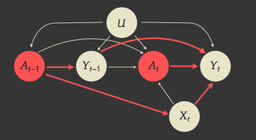How to Make Causal Inferences with Time-Series Cross-Sectional Data under Selection on Observables
American Political Science Review, Vol. 112, No. 4 (2018): 1067-1082
(with Adam Glynn)
Repeated measurements of the same countries, people, or groups over time are vital to many fields of political science. These measurements, sometimes called time-series cross-sectional (TSCS) data, allow researchers to estimate a broad set of causal quantities, including contemporaneous and lagged treatment effects. Unfortunately, popular methods for TSCS data can only produce valid inferences for lagged effects under very strong assumptions. In this paper, we use potential outcomes to define causal quantities of interest in this settings and clarify how standard models like the autoregressive distributed lag model can produce biased estimates of these quantities due to post-treatment conditioning. We then describe two estimation strategies that avoid these post-treatment biases—inverse probability weighting and structural nested mean models—and show via simulations that they can outperform standard approaches in small sample settings. We illustrate these methods in a study of how welfare spending affects terrorism.